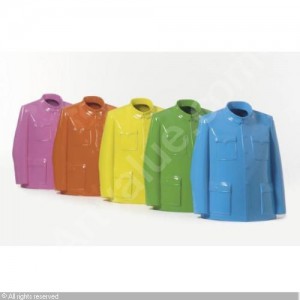
Sui Jianguo – “Legacy Mantle (set of five)” (2006)
Courtney Gallagher
ASNS 2076: Fashion & Gender in China
Lot: 940
Fibreglass with automotive paint
Size: Each: 63.5cm x 48.2cm x 30.4cm (25 x 19 x 12″)
Sui Jianguo’s sculpture, Legacy Mantle, exhibits the socio-economic transformation from Mao’s China (socialist China) to commercial China (post-socialist China).
Body:
Jianguo’s sculptures of the Mao suit are exhibited body-less alluding to a Maoist past in which individual identity was rejected. The body becomes submissive, if not irrelevant, to the Mao suit that seems to be self-supporting. Through this presentation, the individual is seen to submit to the collective, which is represented by the Mao suit. The absence of the body highlights the absence of the identity and individuality in Maoist China, where the individual body only existed as a small part of the larger collective body. The absence of the body in Jianguo’s sculpture not only shows the loss of individuality, but also a submission to the collective. The Mao suits appear in a group of five and self-supporting in order to emphasize how the individual only exists as part of the collective [collective body and collective identity]. Through this piece, the artist criticizes the Maoist period where the absence of the physical body shows the absence of the individual person. The submission that is suggested by the absent body can be seen as a type of “rape” of the individual by the corrupt and unjust CCP.
Color:
The different colors of each of the five Mao suits, contrast with the absence of individuality. The vibrant colors displayed by Jianguo’s Mao suits are a representation of modern contemporary consumerist China. The bright colors give each suit its own uniqueness and individuality. In the Maoist era, the Mao suit generally appeared in all neutral and bland colors, portraying each body as part of the larger collective in the eyes of socialist China. The neutral colors were a representation of collectivity and similarity in that no body had an individual identity. The body was supposed to appear genderless, shapeless, and sexless (masculinized). In the Chinese socialist era, fashion was a form of political oppression—and this was most notably observed through the Mao suit. Politically, the socialist government, through the Mao suit, promoted a specific social behavior that fused the symbolism of Maoist thought and utility. move these comments to the paragraph on body The artist purposefully uses bright colors in order to emphasize the individuality of each of the Mao suits—juxtaposing the collectivity invoked by the absence of bodies. Jianguo uses these colors to represent individuality and prosperity that describes commercial China, or post-socialist China. address how the artist, in terms adding color or coloring the mao suite, rewrite social-political history as china undergoes transition from mao to post mao
The sculpture contrasts two seemingly opposing ideas–the absence of the body and the presence of the vibrant-colored suit—in order to highlight the great changes that have occurred since the transition from socialist China to post-socialist China. He characterizes socialist China as a time where there was no individual, no identity other than that of the collective. Now, however, in post-socialist China, citizens are starting to determine their own identities—and through this they are becoming separate identities (represented by each color being different). Jianguo suggests in this sculpture that although there is a movement to the future, the Chinese people who lived through the Maoist period will not forget what it was like. Although there is a vibrant individual culture growing in China, in a past not so long ago this was not possible for the Chinese people. Through this, the artist celebrates the transformation of China from socialism to post-socialism.
nice post
